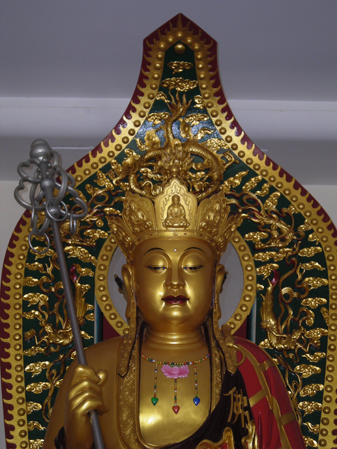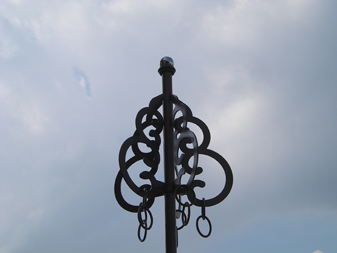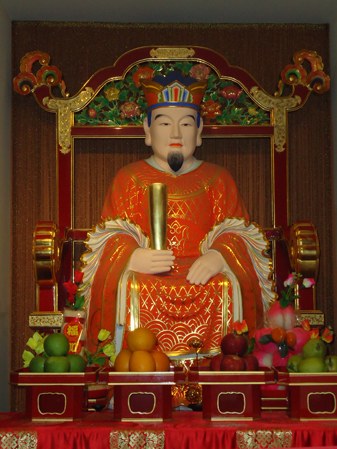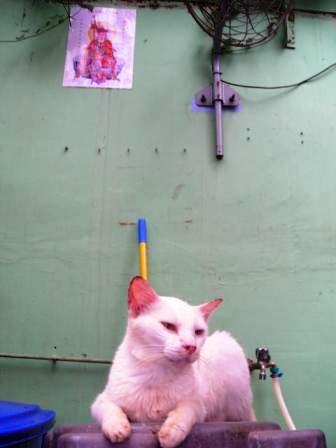Ksitigarbha Bodhisattva
大愿地藏王菩萨
 Ksitigarbha Bodhisattva, 地藏王菩萨, the Bodhisattva of Great Aspiration, is one of the most well-known Bodhisattva in Chinese Mahayana Buddhism. He is also known as Di Zhang Wang Pusa in Chinese and commonly translated as Earth Store Bodhisattva. Ksitigarbha Bodhisattva, 地藏王菩萨, the Bodhisattva of Great Aspiration, is one of the most well-known Bodhisattva in Chinese Mahayana Buddhism. He is also known as Di Zhang Wang Pusa in Chinese and commonly translated as Earth Store Bodhisattva.
The Bodhisattva is also commonly worshipped in Taoist temples especially at the ancestral halls.
The Bodhisattva is known for his great vow to help beings in all realms to gain enlightenment before he would become a Buddha. He is also tasked to teach the Dharma to all beings during the time between the passing of the historical Buddha (Gautama Buddha) and the arrival of Maitreya Buddha.
Previous live of Ksitigarbha Bodhisattva
In an earlier life, Ksitigarbha Bodhisattva was the daughter of a Bramin. When her mother passed away, she made offerings and dedicated the merits to her mother. Eventually, her mother ascended to higher realms because of her merit.
Although relieved, she was affected by sufferings of beings in the lower realm and vowed to help them.
During the Tang Dynasty in China, a Korean monk, Kim Kiaokak, 金喬觉, settled in Anhui Province’s Jiu Hua Shan 九华山to practiced Buddhism.
Over time, the Venerable attracted many devotees and after he passed away, his body never decompose. This was taken by many that he was a reincarnate of Ksitigarbha and Jiu Hua Shan became the pilgrimage site for the Bodhisattva.
Every year, crowds of pilgrims gather at Jiu Hua Shan to commemorate Ksitigarbha Bodhisattva’s birthday on the 30th day of the 7th lunar month, 农历七月三十日. See this year's date.
Symbols associated with Ksitigarbha Bodhisattva
Ksitigarbha Bodhisattva is easily recognised in a Buddhist monastery as he is the only Bodhisattva dressed in a monk’s robe and either bald or wearing a monk’s cap with the Five Dhyani Buddhas.
The Bodhisattva holds a walking staff also commonly used by monks. It has rings on different tiers and is used to alert insects and animals of his coming to avoid accidentally hurting them. In his other hand, he holds a pearl, a lotus flower or ritual objects.
In a Chinese Monastery, sculpture of Ksitigarbha Bodhisattva can be seen near the bell tower or in the hall where ancestral tablets are placed.
Confusions associated with Ksitigarbha Bodhisattva
Ksitigarbha Bodhisattva is commonly mistaken with Maudgalyayana (Mu Lian) of the Hungry Ghost festival, Xuan Zang of Journey to the West and King Yan Luo, the God of Hades.
The confusions arise because the story of Mu Lian is very similar with Ksitigarbha’s earlier existence as Bramin’s daughter, Xuan Zang because of the monks robe and King Yan Luo because Ksitigarbha’s vow to save all being even those in the lower realms created an association between him and beings in the lower realms.
The spirit of Ksitigarbha Bodhisattva
Ksitigarbha Bodhisattva’s great aspiration shares a common theme with other Buddhist Bodhisattvas. When Bodhisattvas made a vow, they went ahead to fulfil it with no strings attached.
They are motivate by their aspirations and do not require the beings they reach out to praise them, love them or worship them.
Ksitigarbha Bodhisattva’s great aspiration can be an inspiration for people to care for fellow beings, to make our world a better place to live in and to reach out with loving kindness but without conditions attached.
Related Articles:
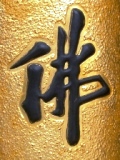
|

 Ksitigarbha Bodhisattva, 地藏王菩萨, the Bodhisattva of Great Aspiration, is one of the most well-known Bodhisattva in Chinese Mahayana
Ksitigarbha Bodhisattva, 地藏王菩萨, the Bodhisattva of Great Aspiration, is one of the most well-known Bodhisattva in Chinese Mahayana 